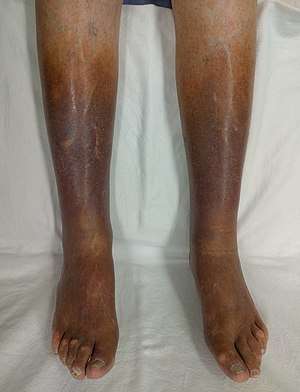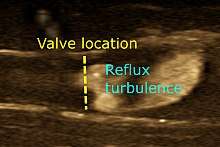Chronic venous insufficiency
Chronic venous insufficiency (CVI) is a medical condition in which blood pools in the veins, straining the walls of the vein.[1] The most common cause of CVI is superficial venous reflux which is a treatable condition.[2] As functional venous valves are required to provide for efficient blood return from the lower extremities, this condition typically affects the legs. If the impaired vein function causes significant symptoms, such as swelling and ulcer formation, it is referred to as chronic venous disease. It is sometimes called chronic peripheral venous insufficiency and should not be confused with post-thrombotic syndrome in which the deep veins have been damaged by previous deep vein thrombosis.
| Chronic venous insufficiency | |
|---|---|
| Other names | Chronic venous disease |
 | |
| Mild chronic venous insufficiency, with increased pigmentation of the lower legs. | |
| Specialty | Vascular surgery |
Most cases of CVI can be improved with treatments to the superficial venous system or stenting the deep system. Varicose veins for example can now be treated by local anesthetic endovenous surgery.
Rates of CVI are higher in women than in men.[3][4] The condition has been known since ancient times and Hippocrates used bandaging to treat it.
Signs and symptoms

Signs and symptoms of CVI in the leg include the following:
- Varicose veins
- Itching (pruritus)
- Hyperpigmentation
- Phlebetic lymphedema[5]
- Chronic swelling of the legs and ankles
- Venous ulceration
CVI in the leg may cause the following:
- Venous stasis
- Ulcers.[6]
- Stasis dermatitis,[6] also known as varicose eczema
- Contact dermatitis,[6] a disrupted epidermal barrier due to venous insufficiency, making patients more susceptible than the general population to contact sensitization and subsequent dermatitis.
- Atrophie blanche,[6] an end point of a variety of conditions that appears as atrophic plaques of ivory white skin with telangiectasias. It represents late sequelae of lipodermatosclerosis where the skin has lost its nutrient blood flow.
- Lipodermatosclerosis, [6] an indurated plaque in the medial malleolus.
- Malignancy,[6] malignant degeneration being a rare but important complication of venous disease since tumors which develop in the setting of an ulcer tend to be more aggressive.
- Pain,[6] a feature of venous disease often overlooked and commonly undertreated.
- Anxiety[6]
- Depression[6]
- Inflammation
- Discoloration
- Skin thickening
- Cellulitis
Causes

The most common cause of chronic venous insufficiency is reflux of the venous valves of superficial veins.[2] This may in turn be caused by several conditions:
- Deep vein thrombosis (DVT), that is, blood clots in the deep veins. Chronic venous insufficiency caused by DVT may be described as postthrombotic syndrome.
- Superficial vein thrombosis.
- Phlebitis
- May–Thurner syndrome. This is a rare condition in which blood clots occur in the iliofemoral vein due to compression of the blood vessels in the leg. The specific problem is compression of the left common iliac vein by the overlying right common iliac artery. Many May-Thurner compressions are overlooked when there is no blood clot. More and more of them get nowadays diagnosed and treated (by stenting) due to advanced imaging techniques.
Deep and superficial vein thrombosis may in turn be caused by thrombophilia, which is an increased propensity of forming blood clots.
Arteriovenous fistula (an abnormal connection or passageway between an artery and a vein) may cause chronic venous insufficiency even with working vein valves.
Diagnosis

History and examination by a clinician for characteristic signs and symptoms are sufficient in many cases in ruling out systemic causes of venous hypertension such as hypervolemia and heart failure.[7] An ultrasound can detect venous obstruction or valvular incompetence as the cause, and is used for planning venous ablation procedures, but it is not necessary in suspected venous insufficiency where surgical intervention is not indicated.[7]
Management
Conservative
Conservative treatment of CVI in the leg involves symptomatic treatment and efforts to prevent the condition from getting worse instead of effecting a cure. This may include
- Manual compression lymphatic massage therapy
- Skin lubrication
- Sequential compression pump
- Ankle pump
- Compression stockings
- Blood pressure medicine
- Hydroxyethylrutoside medication[10]
- Frequent periods of rest elevating the legs above the heart level
- Tilting the bed so that the feet are above the heart. This may be achieved by using a 20 cm (7-inch) bed wedge or sleeping in a 6 degree Trendelenburg position. Obese or pregnant people might be advised by their physicians to forgo the tilted bed.
Surgical
Surgical treatment of CVI attempts a cure by physically changing the veins with incompetent valves. Surgical treatments for CVI include the following:
- Linton procedures (i.e. subfascial ligation of perforating veins in the lower extremity, an older treatment)
- Ligation.[11] Tying off a vein to prevent blood flow
- Vein stripping.[11] Removal of the vein.
- Surgical repair.[11]
- Endovenous Laser Ablation
- Vein transplant.[11]
- Subfascial endoscopic perforator surgery.[11] Tying off the vein with an endoscope.
- Valve repair (experimental)
- Valve transposition (experimental)
- Hemodynamic surgeries.
Venous insufficiency conservative, hemodynamic and ambulatory treatment (CHIVA method) is an ultrasound guided, minimally invasive surgery strategic for the treatment of varicose veins, performed under local anaesthetic.[12]
See also
- Atrophie blanche
- Compression stockings
- Lipodermatosclerosis
- Venography
- Venous stasis
- Venous ulcer
References
- "Chronic Venous Insufficiency". Society for Vascular Surgery. December 1, 2009.
- Whiteley MS (2011). "Understanding Venous Reflux - the cause of varicose veins and venous leg ulcers". Whiteley Publishing. Retrieved January 8, 2015.
- Evans CJ, Fowkes FG, Ruckley CV, Lee AJ (1999). "Prevalence of varicose veins and chronic venous insufficiency in men and women in the general population: Edinburgh Vein Study.J Epidemiol Community Health. 1999 Mar;53(3):149-53". Journal of Epidemiology & Community Health. J Epidemiol Community Health. 53 (3): 149–153. doi:10.1136/jech.53.3.149. PMC 1756838. PMID 10396491. Retrieved January 8, 2015.
- Robertson LA, Evans CJ, Lee AJ, Allan PL, Ruckley CV, Fowkes FG (May 2014). "Incidence and risk factors for venous reflux in the general population: Edinburgh Vein Study. Eur J Vasc Endovasc Surg. 2014 Aug;48(2):208-14. doi: 10.1016/j.ejvs.2014.05.017. Epub 2014 Jun 18". European Journal of Vascular and Endovascular Surgery. Eur J Vasc Endovasc Surg. 48 (2): 208–14. doi:10.1016/j.ejvs.2014.05.017. PMID 24951373. Retrieved January 8, 2015.
- Avril, Stéphane; Badel, Pierre; Dubuis, Laura; Rohan, Pierre-Yves; Debayle, Johan; Couzan, Serge; Pouget, Jean-Fraçois (January 25, 2012). Gefen, Amit (ed.). Patient-Specific Modeling in Tomorrow's Medicine. Springer. p. 220. ISBN 9783642246180. Retrieved August 2015. Check date values in:
|accessdate=(help) - Barron GS, Jacob SE, Kirsner RS (Sep 2007). "Dermatologic complications of chronic venous disease: medical management and beyond". Ann Vasc Surg. 21 (5): 652–62. doi:10.1016/j.avsg.2007.07.002. PMID 17823046.
- Patrick C Alguire, Barbara M Mathes. "Diagnostic evaluation of lower extremity chronic venous insufficiency". Retrieved 2017-09-12. Topic last updated: Dec 04, 2017.
- Antignani, P. L. (August 2001). "Classification of chronic venous insufficiency: a review". Angiology. 52 Suppl 1: S17–26. doi:10.1177/0003319701052001S03. ISSN 0003-3197. PMID 11510593.
- Hafner, Jürg (1999-01-01). Management of Leg Ulcers. Karger Medical and Scientific Publishers. p. 81. ISBN 9783805566544.
- Frick, RW (March 2000). "Three treatments for chronic venous insufficiency: escin, hydroxyethylrutoside, and Daflon". Angiology. 51 (3): 197–205. doi:10.1177/000331970005100303. PMID 10744007.
- "Chronic Venous Insufficiency". hopkinsmedicine.org.
- Mowatt-Larssen, Eric; Shortell, Cynthia (2010). "CHIVA". Seminars in Vascular Surgery. 23 (2): 118–22. doi:10.1053/j.semvascsurg.2010.01.008. PMID 20685567.
External links
| Classification | |
|---|---|
| External resources |